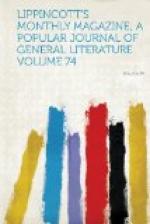One of the finest specimens of cinque-cento wood-work extant in Italy—perhaps I might safely say the finest—is the choir of the monastic church of St. Peter at Perugia. The monks of St. Peter were Benedictines of Monte Cassino, and, like most of the families of that order, they were very wealthy and were liberal patrons of art. On the 9th of April, 1525, having determined to refit the choir of their church in a magnificent manner, they came to an agreement with a master-carpenter of Perugia for the execution of the work, and a detailed contract was signed by the parties. (I have called this cinque-cento work, and it will be observed that it was executed in the sixteenth century. It may be necessary, therefore, to explain to those who are unacquainted with the Italian mode of speaking in this respect that the Italians always speak of what we should call the fourteenth century as the “trecento,” what we should call the fifteenth, as the “quattrecento,” and so on. The period at which art in all its branches culminated in Italy was, in our language, the sixteenth century.)
Maestro Bernardino di Luca, the artist with whom the convent contracted for the fitting of the choir, is styled in the instrument legnaiuolo (a “carpenter"). And no doubt Maestro Bernardino—or “Bino,” for short, as he is called in the instrument when once at the beginning he has been named formally at full length—practiced all the more ordinary business of his trade. But there must have been carpenters and carpenters, as to the present day there are painters and painters, the same word indicating the calling of a Landseer and of a house-painter. This simple modesty of designation was a characteristic of the epoch. We find sculptors whose works are to the present day admired and studied




